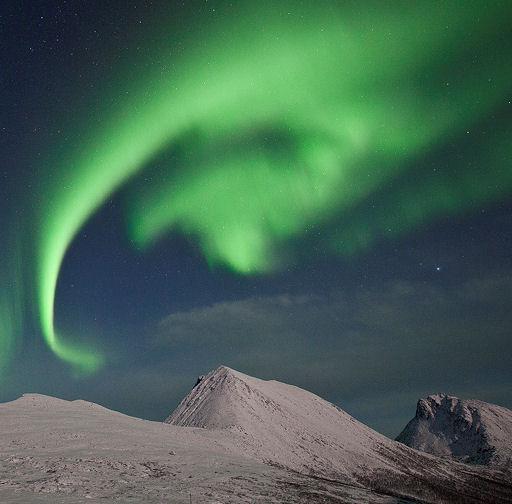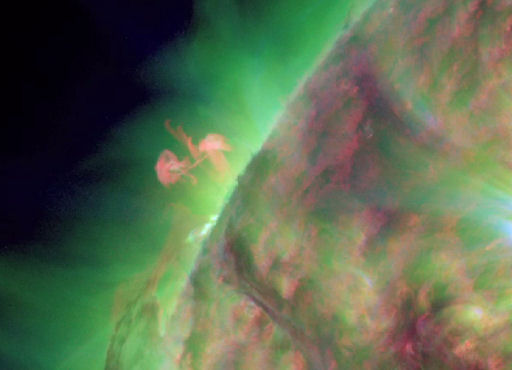Turn your cell phone into a field-tested satellite tracker. Works for Android and iPhone. | | |
SOME COMETS LIKE IT HOT: Astronomers are still scratching their heads over Comet Lovejoy, which plunged through the atmosphere of the sun in December and, against all odds, survived. The comet is now receding into the outer solar system leaving many mysteries behind. [full story] [video]
FRIDAY THE 13TH AURORAS: Who says Friday the 13th is unlucky? Just look how the day began in Tromsø, Norway:

"Friday the 13th started very luckily indeed!" says photographer Antony Spencer. "We enjoyed an incredible display of auroras for five hours. The lights were so bright, even the snow turned green."
The auroras were sparked by the onset of a solar wind stream (~550 km/s), which reached Earth during the early hours of Jan. 13th. More geomagnetic activity is possible tonight as the solar wind continues to blow. Aurora alerts: text, voice.
January 2012 Aurora Gallery
[previous Januaries: 2010, 2009, 2008, 2007, 2005, 2004]
FARSIDE ERUPTION: On Jan. 12th, between 10:00 and 1300 UT, NASA's STEREO-Behind spacecraft observed a significant eruption on the farside of the sun. Although the blast was partially eclipsed by the edge of the solar disk, it nevertheless produced a long-duration X-ray flare (C3-class) detectable from Earth. A movie from NASA's Solar Dynamics Observatory shows some of the debris flying over the NE limb:

The blast site is only ~two days away from rotating onto the Earthside of the sun. By this weekend, we could get a direct look at the active region. Perhaps it will break the recent string of mostly quiet days and low solar activity.
Update: The partially-eclipsed C-flare was strong enough to make waves of ionizaton in Earth's upper atmosphere. This, in turn, disturbed the normal propagation of low-frequency radio waves over Europe. "The C3.3 flare on the far side of the Sun was picked up on my SID monitoring station," reports Dave Gradwell of Birr Ireland. "It affected the 20.9 kHz signal from FTA in France, just before the signal became unstable."
Comet Lovejoy Gallery
[previous comets: McNaught, Holmes, Lulin, Tuttle, Ikeya-Zhang]
Potentially Hazardous Asteroids (
PHAs) are space rocks larger than approximately 100m that can come closer to Earth than 0.05 AU. None of the known PHAs is on a collision course with our planet, although astronomers are finding
new ones all the time.
On January 13, 2012 there were 1272 potentially hazardous asteroids.
Notes: LD means "Lunar Distance." 1 LD = 384,401 km, the distance between Earth and the Moon. 1 LD also equals 0.00256 AU. MAG is the visual magnitude of the asteroid on the date of closest approach. | | The official U.S. government space weather bureau |
| | The first place to look for information about sundogs, pillars, rainbows and related phenomena. |
| | Researchers call it a "Hubble for the sun." SDO is the most advanced solar observatory ever. |
| | 3D views of the sun from NASA's Solar and Terrestrial Relations Observatory |
| | Realtime and archival images of the Sun from SOHO. |
| | from the NOAA Space Environment Center |
| | the underlying science of space weather |

